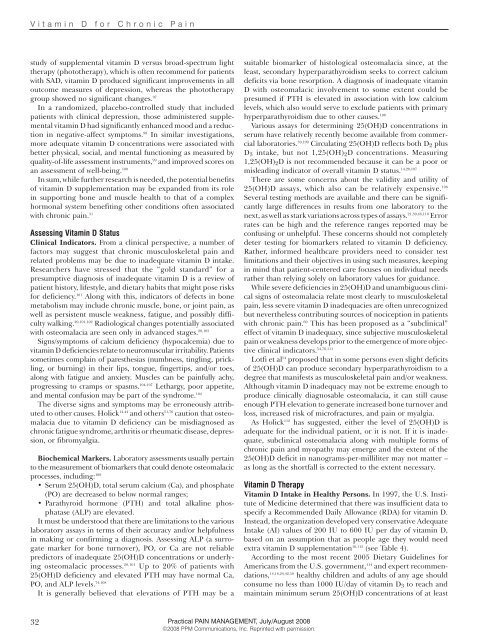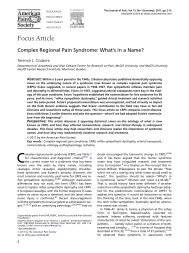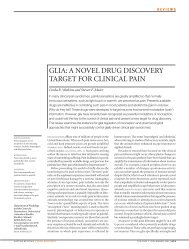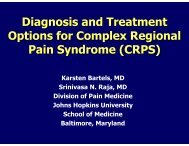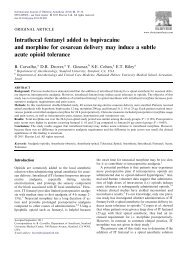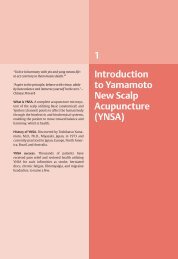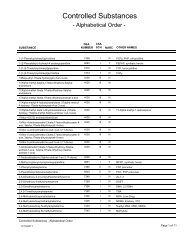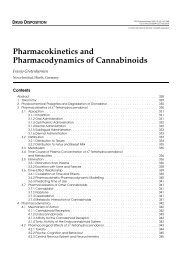1) Vitamin D For Chronic Pain - Pain Treatment Topics.org
1) Vitamin D For Chronic Pain - Pain Treatment Topics.org
1) Vitamin D For Chronic Pain - Pain Treatment Topics.org
Create successful ePaper yourself
Turn your PDF publications into a flip-book with our unique Google optimized e-Paper software.
<strong>Vitamin</strong> D for <strong>Chronic</strong> <strong>Pain</strong><br />
study of supplemental vitamin D versus broad-spectrum light<br />
therapy (phototherapy), which is often recommend for patients<br />
with SAD, vitamin D produced significant improvements in all<br />
outcome measures of depression, whereas the phototherapy<br />
group showed no significant changes. 97<br />
In a randomized, placebo-controlled study that included<br />
patients with clinical depression, those administered supplemental<br />
vitamin D had significantly enhanced mood and a reduction<br />
in negative-affect symptoms. 98 In similar investigations,<br />
more adequate vitamin D concentrations were associated with<br />
better physical, social, and mental functioning as measured by<br />
quality-of-life assessment instruments, 99 and improved scores on<br />
an assessment of well-being. 100<br />
In sum, while further research is needed, the potential benefits<br />
of vitamin D supplementation may be expanded from its role<br />
in supporting bone and muscle health to that of a complex<br />
hormonal system benefiting other conditions often associated<br />
with chronic pain. 31<br />
Assessing <strong>Vitamin</strong> D Status<br />
Clinical Indicators. From a clinical perspective, a number of<br />
factors may suggest that chronic musculoskeletal pain and<br />
related problems may be due to inadequate vitamin D intake.<br />
Researchers have stressed that the “gold standard” for a<br />
presumptive diagnosis of inadequate vitamin D is a review of<br />
patient history, lifestyle, and dietary habits that might pose risks<br />
for deficiency. 101 Along with this, indicators of defects in bone<br />
metabolism may include chronic muscle, bone, or joint pain, as<br />
well as persistent muscle weakness, fatigue, and possibly difficulty<br />
walking. 20,101,102 Radiological changes potentially associated<br />
with osteomalacia are seen only in advanced stages. 20,103<br />
Signs/symptoms of calcium deficiency (hypocalcemia) due to<br />
vitamin D deficiencies relate to neuromuscular irritability. Patients<br />
sometimes complain of paresthesias (numbness, tingling, prickling,<br />
or burning) in their lips, tongue, fingertips, and/or toes,<br />
along with fatigue and anxiety. Muscles can be painfully achy,<br />
progressing to cramps or spasms. 104-107 Lethargy, poor appetite,<br />
and mental confusion may be part of the syndrome. 104<br />
The diverse signs and symptoms may be erroneously attributed<br />
to other causes. Holick 14,44 and others 51,76 caution that osteomalacia<br />
due to vitamin D deficiency can be misdiagnosed as<br />
chronic fatigue syndrome, arthritis or rheumatic disease, depression,<br />
or fibromyalgia.<br />
Biochemical Markers. Laboratory assessments usually pertain<br />
to the measurement of biomarkers that could denote osteomalacic<br />
processes, including: 108<br />
• Serum 25(OH)D, total serum calcium (Ca), and phosphate<br />
(PO) are decreased to below normal ranges;<br />
• Parathyroid hormone (PTH) and total alkaline phosphatase<br />
(ALP) are elevated.<br />
It must be understood that there are limitations to the various<br />
laboratory assays in terms of their accuracy and/or helpfulness<br />
in making or confirming a diagnosis. Assessing ALP (a surrogate<br />
marker for bone turnover), PO, or Ca are not reliable<br />
predictors of inadequate 25(OH)D concentrations or underlying<br />
osteomalacic processes. 28,101 Up to 20% of patients with<br />
25(OH)D deficiency and elevated PTH may have normal Ca,<br />
PO, and ALP levels. 74,108<br />
It is generally believed that elevations of PTH may be a<br />
suitable biomarker of histological osteomalacia since, at the<br />
least, secondary hyperparathyroidism seeks to correct calcium<br />
deficits via bone resorption. A diagnosis of inadequate vitamin<br />
D with osteomalacic involvement to some extent could be<br />
presumed if PTH is elevated in association with low calcium<br />
levels, which also would serve to exclude patients with primary<br />
hyperparathyroidism due to other causes. 108<br />
Various assays for determining 25(OH)D concentrations in<br />
serum have relatively recently become available from commercial<br />
laboratories. 39,109 Circulating 25(OH)D reflects both D 2 plus<br />
D 3 intake, but not 1,25(OH) 2 D concentrations. Measuring<br />
1,25(OH) 2 D is not recommended because it can be a poor or<br />
misleading indicator of overall vitamin D status. 14,28,107<br />
There are some concerns about the validity and utility of<br />
25(OH)D assays, which also can be relatively expensive. 108<br />
Several testing methods are available and there can be significantly<br />
large differences in results from one laboratory to the<br />
next, as well as stark variations across types of assays. 21,39,46,110 Error<br />
rates can be high and the reference ranges reported may be<br />
confusing or unhelpful. These concerns should not completely<br />
deter testing for biomarkers related to vitamin D deficiency.<br />
Rather, informed healthcare providers need to consider test<br />
limitations and their objectives in using such measures, keeping<br />
in mind that patient-centered care focuses on individual needs<br />
rather than relying solely on laboratory values for guidance.<br />
While severe deficiencies in 25(OH)D and unambiguous clinical<br />
signs of osteomalacia relate most clearly to musculoskeletal<br />
pain, less severe vitamin D inadequacies are often unrecognized<br />
but nevertheless contributing sources of nociception in patients<br />
with chronic pain. 60 This has been proposed as a “subclinical”<br />
effect of vitamin D inadequacy, since subjective musculoskeletal<br />
pain or weakness develops prior to the emergence of more objective<br />
clinical indicators. 54,76,111<br />
Lotfi et al 54 proposed that in some persons even slight deficits<br />
of 25(OH)D can produce secondary hyperparathyroidism to a<br />
degree that manifests as musculoskeletal pain and/or weakness.<br />
Although vitamin D inadequacy may not be extreme enough to<br />
produce clinically diagnosable osteomalacia, it can still cause<br />
enough PTH elevation to generate increased bone turnover and<br />
loss, increased risk of microfractures, and pain or myalgia.<br />
As Holick 112 has suggested, either the level of 25(OH)D is<br />
adequate for the individual patient, or it is not. If it is inadequate,<br />
subclinical osteomalacia along with multiple forms of<br />
chronic pain and myopathy may emerge and the extent of the<br />
25(OH)D deficit in nanograms-per-milliliter may not matter –<br />
as long as the shortfall is corrected to the extent necessary.<br />
<strong>Vitamin</strong> D Therapy<br />
<strong>Vitamin</strong> D Intake in Healthy Persons. In 1997, the U.S. Institute<br />
of Medicine determined that there was insufficient data to<br />
specify a Recommended Daily Allowance (RDA) for vitamin D.<br />
Instead, the <strong>org</strong>anization developed very conservative Adequate<br />
Intake (AI) values of 200 IU to 600 IU per day of vitamin D,<br />
based on an assumption that as people age they would need<br />
extra vitamin D supplementation 16,113 (see Table 4).<br />
According to the most recent 2005 Dietary Guidelines for<br />
Americans from the U.S. government, 114 and expert recommendations,<br />
14,18,24,42,58 healthy children and adults of any age should<br />
consume no less than 1000 IU/day of vitamin D 3 to reach and<br />
maintain minimum serum 25(OH)D concentrations of at least<br />
32 Practical PAIN MANAGEMENT, July/August 2008<br />
©2008 PPM Communications, Inc. Reprinted with permission.


